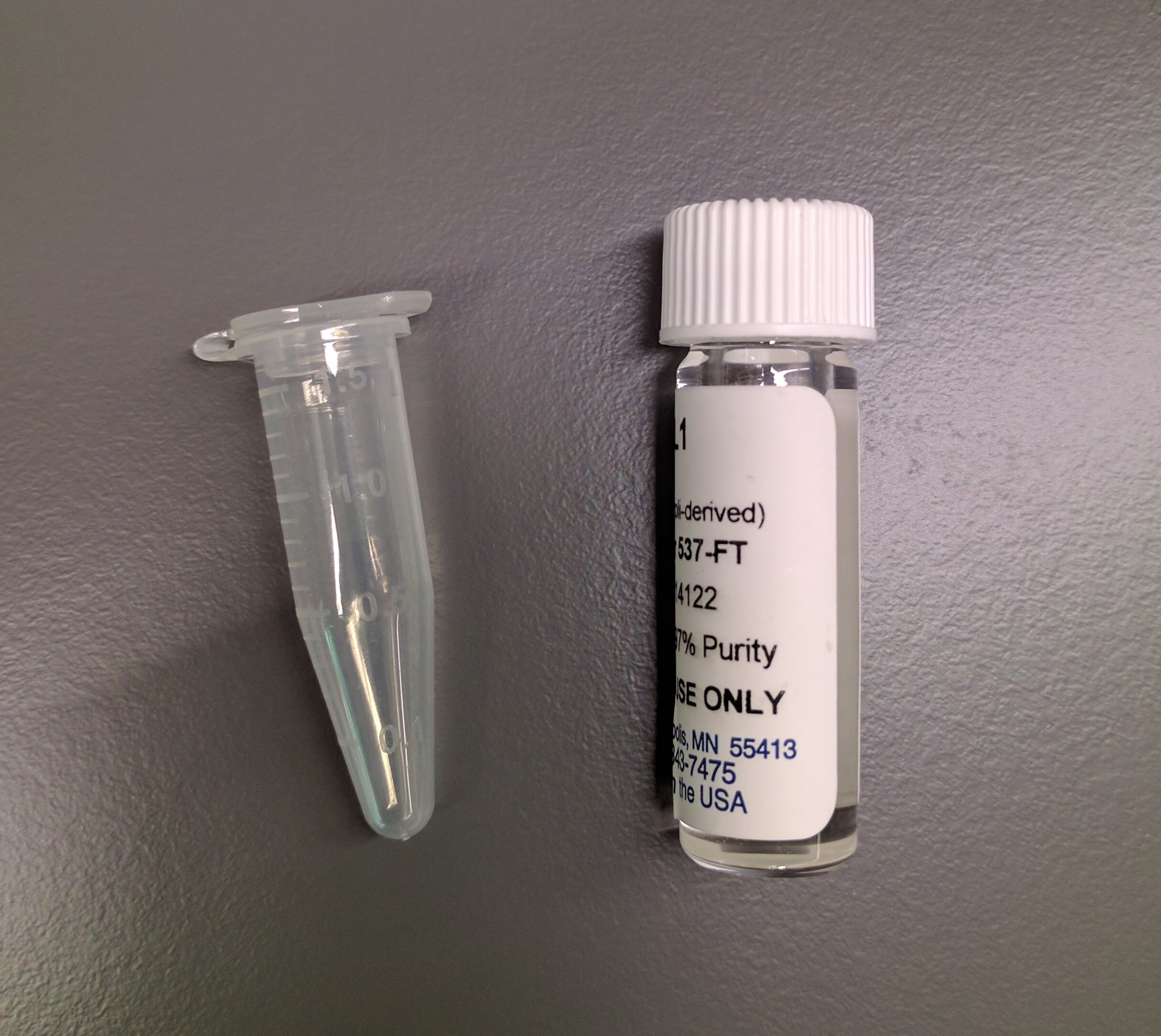Recombinant Rat CX3CL1/Fractalkine (Chemokine Domain)
Recombinant Rat CX3CL1/Fractalkine (Chemokine Domain) Summary
- R&D Systems E. coli-derived Recombinant Rat CX3CL1/Fractalkine (Chemokine Domain) (537-FT)
- Quality control testing to verify active proteins with lot specific assays by in-house scientists
- All R&D Systems proteins are covered with a 100% guarantee
Product Specifications
Gln25-Gly100
Analysis
Product Datasheets
Carrier Free
CF stands for Carrier Free (CF). We typically add Bovine Serum Albumin (BSA) as a carrier protein to our recombinant proteins. Adding a carrier protein enhances protein stability, increases shelf-life, and allows the recombinant protein to be stored at a more dilute concentration. The carrier free version does not contain BSA.
In general, we advise purchasing the recombinant protein with BSA for use in cell or tissue culture, or as an ELISA standard. In contrast, the carrier free protein is recommended for applications, in which the presence of BSA could interfere.
537-FT
| Formulation | Lyophilized from a 0.2 μm filtered solution in Acetonitrile and TFA with BSA as a carrier protein. |
| Reconstitution | Reconstitute at 100 μg/mL in sterile PBS containing at least 0.1% human or bovine serum albumin. |
| Shipping | The product is shipped at ambient temperature. Upon receipt, store it immediately at the temperature recommended below. |
| Stability & Storage: | Use a manual defrost freezer and avoid repeated freeze-thaw cycles.
|
537-FT/CF
| Formulation | Lyophilized from a 0.2 μm filtered solution in Acetonitrile and TFA. |
| Reconstitution | Reconstitute at 100 μg/mL in sterile PBS. |
| Shipping | The product is shipped at ambient temperature. Upon receipt, store it immediately at the temperature recommended below. |
| Stability & Storage: | Use a manual defrost freezer and avoid repeated freeze-thaw cycles.
|
Reconstitution Calculator
Background: CX3CL1/Fractalkine
CX3CL1, also named neurotactin, is a member of the delta chemokine subfamily that contains a novel C-X3-C motif. Unlike other known chemokines, CX3CL1 is a type 1 membrane protein containing a chemokine domain tethered on a long mucin-like stalk. Rat CX3CL1 cDNA encodes a 393 amino acid (aa) residue precursor protein with two alternative (21 aa or 24 aa residue) putative signal peptides, a 76 aa residue globular chemokine domain, a 238 aa residue stalk region rich in Gly, Pro, Ser and Thr and containing degenerate mucin-like repeats, a 19 aa residue transmembrane segment and a 36 aa residue cytoplasmic domain. The extracellular domain of CX3CL1 can potentially be released as a soluble protein by proteolysis at the conserved dibasic motif proximal to the transmembrane region. With the exception of the stalk region, rat CX3CL1 shares a high degree of amino sequence homology (83% sequence identity) with human and mouse CX3CL1. CX3CL1 is expressed in various tissues including heart, brain, lung, kidney, skeletal muscle, and testis. In rat brain, CX3CL1 expression was found to be localized principally to neurons. The expression of CX3CL1 was also reported to be up‑regulated on activated endothelial cells. Membrane‑bound CX3CL1 has been shown to promote adhesion of leukocytes. The soluble chemokine domain of human CX3CL1 was reported to be chemotactic for T cells and monocytes while the soluble chemokine domain of mouse CX3CL1 was reported to chemoattract neutrophils and T‑lymphocytes but not monocytes. CX3CR1, previously named V28 or chemokine beta receptor‑like 1, has been found to be a specific receptor for CX3CL1. In addition, US28, a 7TM receptor encoded by human cytomegalovirus that binds multiple CC chemokines, has also been shown to bind fractalkine with high-affinity.
- Kledal, T.N. et al. (1998) FEBS Lett. 441:209.
- Combadiere, C. et al. (1998) J. Biol. Chem. 273:23799.
- Harrison, J.L. et al. (1998) Proc. Natl. Acad. Sci. USA 95:10896.
- Rossi, D.L. et al. (1998) Genomics 47:163.
Citations for Recombinant Rat CX3CL1/Fractalkine (Chemokine Domain)
R&D Systems personnel manually curate a database that contains references using R&D Systems products. The data collected includes not only links to publications in PubMed, but also provides information about sample types, species, and experimental conditions.
5
Citations: Showing 1 - 5
Filter your results:
Filter by:
-
Enhancing fractalkine/CX3CR1 signalling pathway can reduce neuroinflammation by attenuating microglia activation in experimental diabetic retinopathy
Authors: M Jiang, H Xie, C Zhang, T Wang, H Tian, L Lu, JY Xu, GT Xu, L Liu, J Zhang
Journal of Cellular and Molecular Medicine, 2022-01-11;0(0):.
Species: Rat
Sample Types: In Vivo
Applications: Bioassay -
Selective activation of microglia facilitates synaptic strength.
Authors: Clark A, Gruber-Schoffnegger D, Drdla-Schutting R, Gerhold K, Malcangio M, Sandkuhler J
J Neurosci, 2015-03-18;35(11):4552-70.
Species: Rat
Sample Types: Whole Cells
Applications: Bioassay -
Cytokine expression profiling of the myocardium reveals a role for CX3CL1 (fractalkine) in heart failure.
Authors: Husberg C, Nygard S, Finsen AV, Damas JK, Frigessi A, Oie E, Waehre A, Gullestad L, Aukrust P, Yndestad A, Christensen G
J. Mol. Cell. Cardiol., 2008-05-28;45(2):261-9.
Species: Rat
Sample Types: Whole Cells
Applications: Bioassay -
The chemokine CX3CL1/fractalkine interferes with the antinociceptive effect induced by opioid agonists in the periaqueductal grey of rats.
Authors: Chen X, Geller EB, Rogers TJ, Adler MW
Brain Res., 2007-03-28;1153(0):52-7.
Species: Rat
Sample Types: In Vivo
Applications: In Vivo -
Role of the CX3CR1/p38 MAPK pathway in spinal microglia for the development of neuropathic pain following nerve injury-induced cleavage of fractalkine.
Authors: Zhuang ZY, Kawasaki Y, Tan PH, Wen YR, Huang J, Ji RR
Brain Behav. Immun., 2006-12-15;21(5):642-51.
Species: Rat
Sample Types: In Vivo
Applications: In Vivo
FAQs
No product specific FAQs exist for this product, however you may
View all Proteins and Enzyme FAQsReviews for Recombinant Rat CX3CL1/Fractalkine (Chemokine Domain)
Average Rating: 4 (Based on 1 Review)
Have you used Recombinant Rat CX3CL1/Fractalkine (Chemokine Domain)?
Submit a review and receive an Amazon gift card.
$25/€18/£15/$25CAN/¥75 Yuan/¥2500 Yen for a review with an image
$10/€7/£6/$10 CAD/¥70 Yuan/¥1110 Yen for a review without an image
Filter by:




